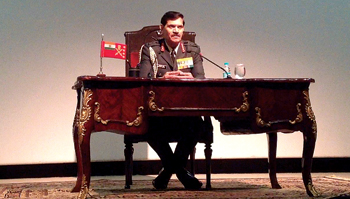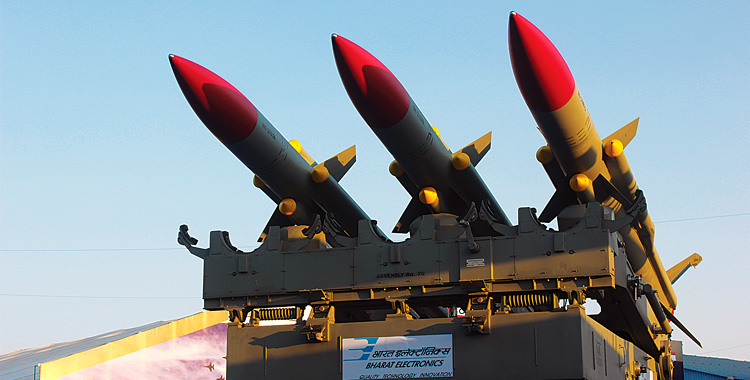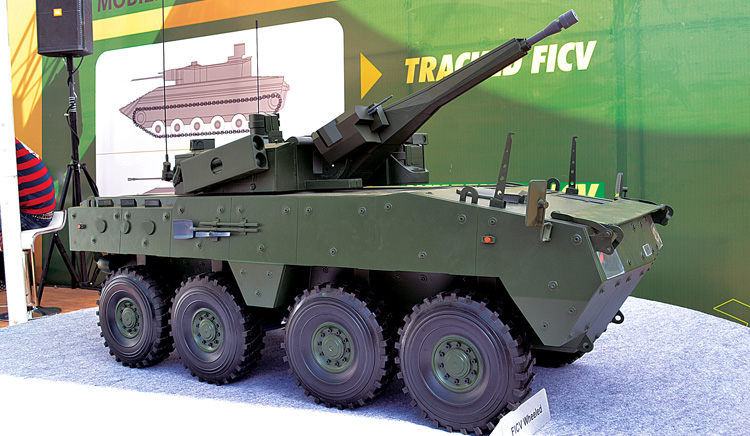INDIAN ARMED FORCES CHIEFS ON OUR RELENTLESS AND FOCUSED PUBLISHING EFFORTS

The insightful articles, inspiring narrations and analytical perspectives presented by the Editorial Team, establish an alluring connect with the reader. My compliments and best wishes to SP Guide Publications.

"Over the past 60 years, the growth of SP Guide Publications has mirrored the rising stature of Indian Navy. Its well-researched and informative magazines on Defence and Aerospace sector have served to shape an educated opinion of our military personnel, policy makers and the public alike. I wish SP's Publication team continued success, fair winds and following seas in all future endeavour!"

Since, its inception in 1964, SP Guide Publications has consistently demonstrated commitment to high-quality journalism in the aerospace and defence sectors, earning a well-deserved reputation as Asia's largest media house in this domain. I wish SP Guide Publications continued success in its pursuit of excellence.
- Appointments Committee of Cabinet approves one-month extension in service of Chief of the Army Staff
- Admiral Dinesh K. Tripathi assumes Command of the Indian Navy as 26th Chief of the Naval Staff
- Prime Minister witnesses 'Bharat Shakti' – a Tri-Services Firing and Manoeuvre Exercise in Pokhran, Rajasthan
- Interim Defence Budget 2024-25 — An Analysis
- Union Defence budget 2024
- Prime Minister Modi Commemorates Indian Navy Day in a Grand Ceremony
Modernisation Through ‘Make in India’ — COAS
The acquisition process has been prioritised and has been divided into three categories: First is Critical, second is Important and third is Essential

SP’s M.A.I.: Quick questions
Jayant Baranwal: What are the new security challenges?
COAS: The dynamics of security challenges keep changing with time, the environment prevailing not only in India but in our neighbourhood and across. The new security challenges that have now emerged, one is cyber threat which is a main challenge that we have to counter. We are taking certain steps towards this, whether it is creation of firewalls, the number of layers that we are creating, the age gap between the computers, the education of people on ground and also sensitising the environment. We have a cyber group here at the Army Headquarters and there are establishments created, certain organisations at the formation level which are looking into this aspect. Also, we carry out a cyber audit periodically to ensure that the security of this aspect is taken care of. This is one basic area, otherwise asymmetric threat has only increased. Every time you find the answer to one, another comes up.
Baranwal: Are we equipped enough today to handle any kind of conflicts or we are still stuck with the point where General Malik had said during Kargil “We shall fight with what we have”?
COAS: There are areas where there has been very little progress or no progress. For example, the acquisition of artillery guns. For the last 28 years, we have not got a single piece added to our inventory, so there are certain deficiencies of that kind. But there has been substantial progress, at least in the last year-and-a-half, on this account. Very large number of clearances have been given on major procurement cases. Talking about Arty itself, 814 guns were cleared. Whether it is Vajra or Dhanush, they are at various stages of procurement. So a large number of procurement cases of major equipment and ammunition are definitely moving ahead. It will take some time. I think in the near future we will start feeling the effect.
Baranwal: Will fast-tracked modernisation process keep the ‘Make in India’ on side to meet the immediate and critical requirements?
COAS: For both the critical and important projects, we will Buy and Make (Indian), because if it is critical, it is immediate and ‘Make in India’ will take some time. We will straight away provide what is minimum required, thereafter, through the transfer of technology we will make the balance quantity.
The traditional anual army Day media interaction of the Chief of the Army Staff General Dalbir Singh was hijacked by the issue of terror attacks on Pathankot airbase and the role played by Army along with other security agencies.
However, the Chief of the Army Staff (COAS) did talk at length about the security challenges the Army is facing and its modernisation process. Regarding modernisation, the Army Chief revealed that the acquisition process has been prioritised and has been divided into three categories: First is Critical, second is Important and third is Essential. According to the Chief, the Army Headquarters has made provisions for seven items under Critical, 17 systems under Important and rest in Essential category.
“We are focusing on the critical and important areas in last two years,” said the Army Chief. The artillery guns and upgradation of air defence guns like Schilka have been included in the Critical list, which are being upgraded regularly. In this list, we are also giving priority to the SRSAM and MRSAM system acquisitions and all are moving in desired manner. The acquisition of selfpropelled towed guns and other categories of guns are moving in right directions. The upgradation of the mechanised forces are also going on,” said the Army Chief.
The Defence Acquisition Council has also cleared third-generation missile systems. Akash missile has also been inducted in the Army. We are totally focusing on modernisation. The COAS revealed that “the Vice Chief keeps a track on the modernisation process on a daily basis and I take a look at it on a weekly basis. ‘Make in India’, I feel, is critical. Many systems we have to buy immediately and then there are systems to be acquired through the transfer of technology.”
The Army Chief rejected media reports that the decision to set up the Mountain Strike Corps has been curtailed substantially. He emphatically rebutted media reports that the Mountain Strike Corps will not be set up in its original plan, due to funds crunch. The Army Chief asserted that it is going as per plan and the Corps will be raised as per schedule by 2021. He also repudiated media reports that there has been instructions from certain quarters to slow down the raising of the Corps. He asserted that there has been no budgetary cuts.
Talking about Army’s role in national security the Chief said that the Indian Army and media play a crucial role in national security. It is this convergence and synergy of efforts that plays a vital link in national security and society. He complimented the media for their support to the Indian Army which has been a force multiplier in nation-building efforts.
In Indian context the challenges the Army is facing is to preserve national interests against internal and external threats. Referring to disputes on the line of control (LOC) and line of actual control (LAC) and ceasefire violations and insurgency in the Northeast, the Army Chief asserted that the Army is ever ready to face any challenges thrown to them. He said that effective management of undemarcated LAC on northern borders, consolidation of internal security situation in the Northeast remains an ongoing commitment. Regarding the ongoing proxy war in Jammu and Kashmir and insurgency in the Northeast, the Chief said that the national security challenges continue to pose serious threats. To effectively meet all these challenges this gives inherent primacy to land forces. Apart from the traditional economic threats we have the existing external and internal threats and regional security dynamics.
Army Design Bureau
The Army Chief said that a large number of measures have been initiated to expedite the induction of modern hardware and systems. The acquisition of systems will be done through the Defence Procurement Procedure (DPP) which should be getting promulgated very soon. This will surely ensure probity and transparency, and greater accountability in defence acquisitions. The Army Chief said that no nation can aspire to acquire a great power status without indigenous research and development and defence production base. In line with the ‘Make in India’ programme of the Government of India, the Indian Army is pursuing an ambitious indigenisation programme to meet the modernisation target. Our advances in this domain have been substantive. General Dalbir Singh said that he would like to share that maximum acceptance of necessity for the Army has been accorded in the category of Buy and Make (Indian).

He also claimed that 50 per cent of the procurement contracts have been issued to the Indian industry. In the past two years, 55 per cent of our modernisation budget has been spent on indigenous industry to meet long-term needs of the Indian Army. In line with the ‘Make in India’ programme the Indian Army is pursuing indigenous programme. In last five years we have cleared 63 per cent of procurement contracts with Indian industry.
In terms of value, 55 per cent of Indian budget has been spent on indigenous programme. The Army Headquarters has also set up the Army Design Bureau to provide technical inputs to the Defence Research and Development Organisation (DRDO) along with the relevant manufacturing agencies. The Army thus would find it easier to help in ‘Make in India’ programme. Despite the technological advances it is the man behind the machine, but it is the machine that counts. Under ‘Make in India’ scheme the future infantry combat vehicle (FICV), upgrades of BMP, future ready combat vehicle (FRCV) will be handed over to the Indian private sector for long-term needs of the Indian Army. Workshops have recently been conducted in Delhi and planned in major industrial hubs like Bengaluru and Ahmedabad. And we also occasionally organise meetings with the Indian industry.

The Army Design Bureau is being set up to concentrate on design expertise and to provide technical inputs and expertise to DRDO and will also help in the ‘Make in India’ programme. All of these initiatives are designed to enhance domestic capabilities.
Emphasising the importance of maintaining the high morale of the men, the Army Chief said that It is vitally important to maintain the human resource. He assured the nation that Army is highly motivated and fully ready to respond to threats.
In response to a question by SP Guide Publications, the Army Chief said that “the security challenges keep changing in a dynamic environment. We focus on cyber threats and also carry out cyber audit. Besides, the asymmetric threat is on rise. There are areas in which there has been very little progress or no progress. For example, the acquisition of artillery guns as we have not got the guns for 28 years. However, we have seen progress in recent years. The acquisition of artillery guns have been cleared. Large number of procurement cases have been cleared. These are in various stages of implementation. The government has cleared the acquisition of 814 guns. The Vajra and Dhanush are in various stages of procurements and trials. As far as procurement of bullet proof jackets is concerned the acquisition process of about 1,86,000 bullet proof jackets is under way. First trials have been completed and the second trials are on. The Army has also issued new General Staff Qualitative Requirements (GSQR) for 60,000 bullet proof jackets.”





